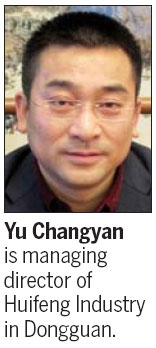Machine made

Manufacturers make hay as labor costs push garment makers toward automation
Rising labor and wage costs as well as uncertain business prospects are prompting garment makers in Dongguan to trim employee numbers and use high-efficiency machines for the manufacturing process.
"High-end garment machines are becoming popular with the factory owners as they want to reduce the spending on skilled workers. Most of the factories in Dongguan have installed large-scale cloth making machines imported from Germany, Italy, the US and Japan along with some homegrown machines," says Luo Liying, deputy secretary-general of the Dongguan Humen Clothing and Accessories Industry Association.
|

|
According to the Dongguan Association of Textile and Garment Industry, the average monthly salary of a garment worker soared to about 2,700 yuan ($428, 325 euros) in January this year, a 30 percent increase over last year. Factory owners also have to pay higher wages for the employees working on extra shifts.
The garment industry is a typical labor-intensive sector and requires experienced workers. Due to the labor shortage, companies prefer modern garment-making machines with higher efficiency.
Luo says that advanced garment making machines manned by a few workers can reduce costs by 40 percent and boost productivity by 40 percent.
"By introducing garment making machines in different workshops, a medium-sized factory can cut its workforce from 1,200 to 800," she says.
Although garment making machines cannot completely replace physical workers like industrial robots, they can boost efficiency and cut down apprentices' training time as many factories at all levels are being forced to seek practical ways to survive amid a changing economic landscape.
Yu Changyan, managing director of Huifeng Industry based in Humen town, Dongguan, says the mechanization trend started two years ago when workers' salaries started climbing.
Yu's company is the owner of Dongguan Humen International Garment Machinery Market. Attracted by the developing potential of Dongguan's garment industry, Huifeng has invested nearly 100 million yuan to build the market in 2010.
"The shift is still in its early stage. But it could indicate a deeper economic motivation because it comes at an important time when garment factory owners are depending on machines to boost production. The labor shortage in Dongguan could last for another five or six years, and so we are hugely dependent on automation to make stable profits," Yu says.
Currently, there are 82 dealers in the market selling a comprehensive range of garment machinery from high-speed sewing, printing and laser-cutting machines to whole advanced production lines for making all sorts of garments. Nearly 80 percent of them are dealing with Chinese brands, while the remaining represent foreign companies. Most of these companies not only sell the machines, but also offer other services like leasing and used equipment sales.
So far, the market has sold machines to local buyers and clients from India, Pakistan, Vietnam and Cambodia. It sold 70 million yuan worth of machines to both domestic and foreign clients in 2011, and is targeting sales of about 100 million yuan this year.
At the market it is the local machines that score over their foreign peers, largely due to the price advantage. Energy-saving and low-noise machines from foreign or local brands are the most sought-after products at the market.
"Though foreign machines have a technological edge over Chinese brands, their prices are 30 percent more than the local ones," says Lin Chao, vice-general manager of Huifeng and the manager of Dongguan Humen International Garment Machinery Market.
Huifeng is keen to attract more factory owners and increase the number of dealerships at the market. It has already charted plans to double the market size by investing another 120 million yuan this year, with the new part of the market expected to be fully operational by the end of 2013.
Li Ganqiu, spokesman for the Dongguan economic and information technology bureau, says though all the garment factories in the city are equipped with different types of machines, many factories are still short of hands and there are more than 12,000 job vacancies that need to be filled.
"The rising demand for garment machines is just a small part of the outcome of China's fast industrial development and improved social wealth distribution to the nation's working class," says Gao Yupeng, deputy secretary-general of Dongguan Association of Textile and Garment Industry.
Gao says using machines can help prevent material wastage and ensure product quality and manufacturing accuracy.
"However, Dongguan's garment factories need to avoid being fully mechanized, because the companies in the US and Europe are capable of doing the same thing in their own countries. It may lead to a situation when they will stop garment imports from China. Semi-mechanized production is probably the best way to ensure exports and maintain the price advantage."
zhongnan@chinadaily.com.cn
Today's Top News
- Xi calls for promoting volunteer spirit to serve national rejuvenation
- Xi chairs CPC meeting to review report on central discipline inspection
- Reunification will only make Taiwan better
- Outline of Xi's thought on strengthening military published
- Targeted action plan to unleash consumption momentum
- Separatist plans of Lai slammed






























